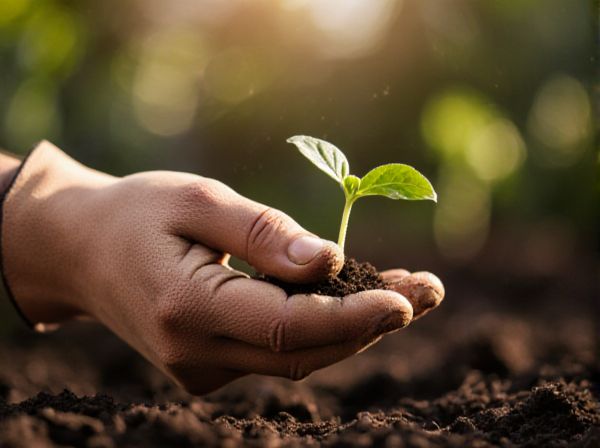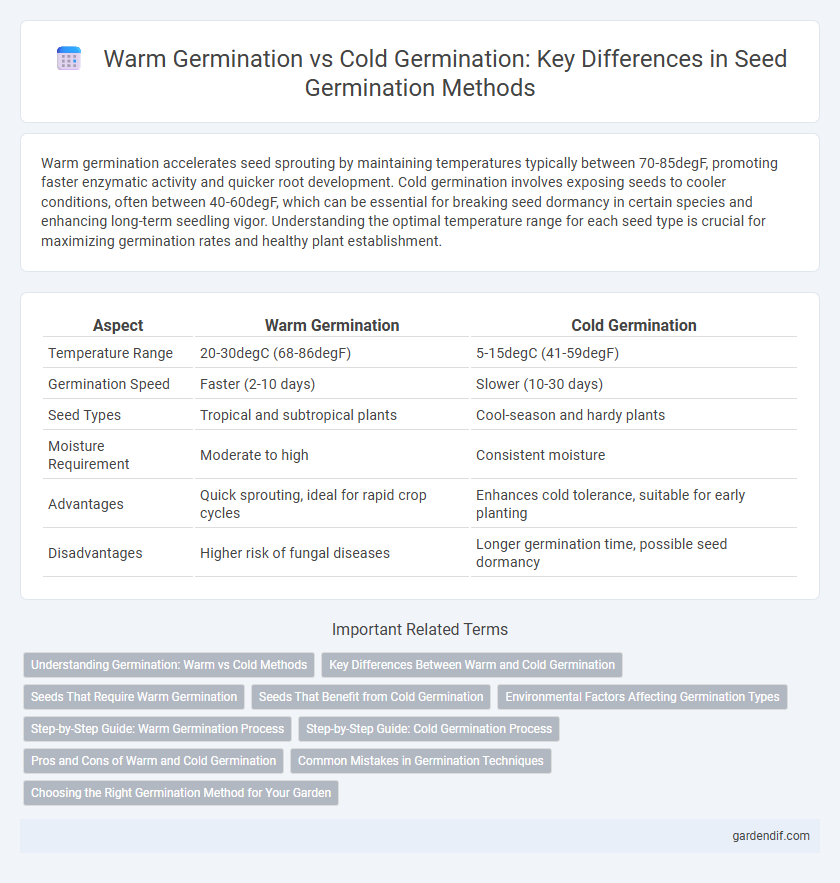
Warm Germination vs Cold Germination Illustration
Warm germination accelerates seed sprouting by maintaining temperatures typically between 70-85degF, promoting faster enzymatic activity and quicker root development. Cold germination involves exposing seeds to cooler conditions, often between 40-60degF, which can be essential for breaking seed dormancy in certain species and enhancing long-term seedling vigor. Understanding the optimal temperature range for each seed type is crucial for maximizing germination rates and healthy plant establishment.
Table of Comparison
| Aspect | Warm Germination | Cold Germination |
|---|---|---|
| Temperature Range | 20-30degC (68-86degF) | 5-15degC (41-59degF) |
| Germination Speed | Faster (2-10 days) | Slower (10-30 days) |
| Seed Types | Tropical and subtropical plants | Cool-season and hardy plants |
| Moisture Requirement | Moderate to high | Consistent moisture |
| Advantages | Quick sprouting, ideal for rapid crop cycles | Enhances cold tolerance, suitable for early planting |
| Disadvantages | Higher risk of fungal diseases | Longer germination time, possible seed dormancy |
Understanding Germination: Warm vs Cold Methods
Warm germination typically occurs at temperatures between 68-86degF (20-30degC), promoting faster seed metabolism and quicker sprouting, ideal for tropical and subtropical plants. Cold germination, often conducted at 32-50degF (0-10degC), mimics natural winter conditions to break seed dormancy through stratification, enhancing germination rates in temperate species. Understanding these temperature-dependent methods enables optimized seedling growth by aligning germination practices with specific plant ecological adaptations.
Key Differences Between Warm and Cold Germination
Warm germination typically occurs at temperatures between 70degF and 85degF, promoting faster seed sprouting and accelerated metabolic activity. Cold germination happens at lower temperatures, around 32degF to 50degF, resulting in slower seed development and sometimes increased dormancy-breaking for certain species. Key differences include temperature range, germination speed, and suitability for specific plant types that require either warm or cold stratification for optimal growth.
Seeds That Require Warm Germination
Seeds that require warm germination typically need soil temperatures between 70degF and 85degF to break dormancy and begin sprouting efficiently. Warm germination accelerates metabolic processes, ensuring optimal enzyme activity and cellular division critical for early seedling development. Common examples include tropical plants and many vegetables like tomatoes and peppers, which fail to germinate or exhibit delayed growth in cooler conditions.
Seeds That Benefit from Cold Germination
Seeds of many perennial plants, such as apple, cherry, and pine, benefit from cold germination, a process that mimics natural winter conditions to break seed dormancy. Cold stratification involves exposing seeds to moist, low temperatures, typically between 1-5degC, for several weeks to months, enhancing enzyme activity and hormone balance that trigger germination. This method improves germination rates and synchronizes sprouting, especially in seeds with hard coats or physiological dormancy requiring chilling periods.
Environmental Factors Affecting Germination Types
Warm germination thrives in temperatures between 20degC to 30degC, accelerating enzymatic activity and seed metabolism, essential for crops like beans and corn. Cold germination occurs at lower temperatures, often ranging from 5degC to 15degC, favoring seeds such as spinach and lettuce that require cooler conditions to break dormancy. Soil moisture, oxygen availability, and light exposure critically interact with temperature to determine the success of warm or cold germination processes.
Step-by-Step Guide: Warm Germination Process
Warm germination accelerates seed sprouting by maintaining soil temperatures between 70degF and 85degF, ideal for tropical and subtropical plants. Begin by soaking seeds in warm water for 12-24 hours to soften the seed coat, then plant them in a well-draining seed-starting mix, keeping the soil consistently moist but not waterlogged. Place the seed tray in a warm environment or use a heat mat to sustain the optimal temperature, monitoring daily until seedlings emerge, typically within 7-14 days.
Step-by-Step Guide: Cold Germination Process
Cold germination involves soaking seeds in a cool, moist environment between 35-50degF (1.5-10degC) for several weeks to simulate winter conditions and break seed dormancy. Place seeds in a damp paper towel or peat moss inside a sealed plastic bag, then store in the refrigerator away from fruits that emit ethylene gas, which can damage seeds. After 4-8 weeks, transfer seeds to a warm environment to encourage sprouting, ensuring optimal moisture and light conditions for successful germination.
Pros and Cons of Warm and Cold Germination
Warm germination accelerates seed sprouting by activating enzymes and metabolic processes, resulting in faster plant growth and earlier harvests; however, it requires consistent temperature control and higher energy input. Cold germination promotes natural dormancy breaking and enhances seedling vigor by mimicking seasonal cues, reducing disease risk but resulting in slower germination rates and prolonged growth cycles. Selecting between warm and cold germination depends on species-specific temperature tolerance, environmental conditions, and crop production timelines.
Common Mistakes in Germination Techniques
Common mistakes in warm germination include overheating seeds beyond optimal temperature ranges (70-85degF), leading to embryo damage and poor sprout development. In cold germination, improper chilling durations or temperature fluctuations below 40degF often cause seed dormancy or mold growth. Both methods suffer from inadequate moisture control, resulting in either desiccation or waterlogging, which significantly decreases germination rates.
Choosing the Right Germination Method for Your Garden
Warm germination accelerates seed sprouting by maintaining temperatures between 70-85degF, ideal for tropical and subtropical plants such as tomatoes and peppers. Cold germination, with temperatures ranging from 40-60degF, mimics natural winter conditions necessary for seeds like carrots and lettuce that require stratification. Selecting the appropriate germination method depends on the seed's temperature requirements, ensuring optimal sprouting rates and healthy seedling development for your garden.
Warm Germination vs Cold Germination Infographic

 gardendif.com
gardendif.com